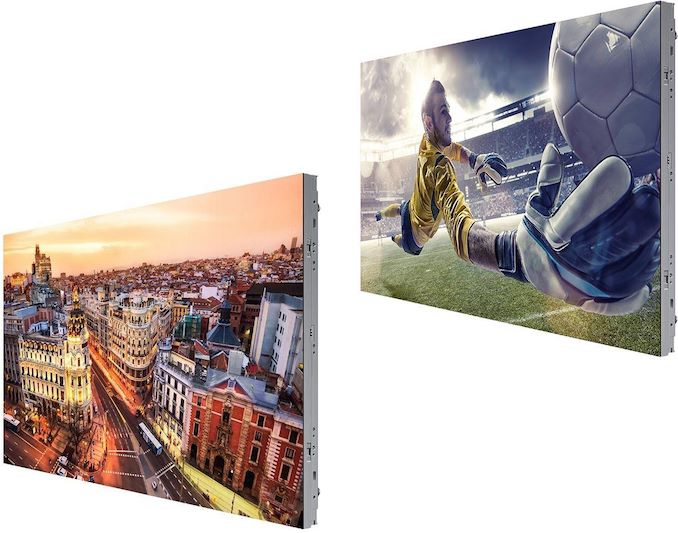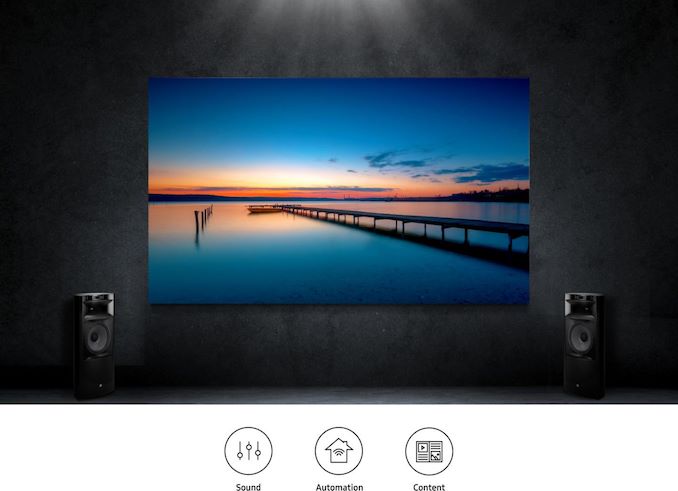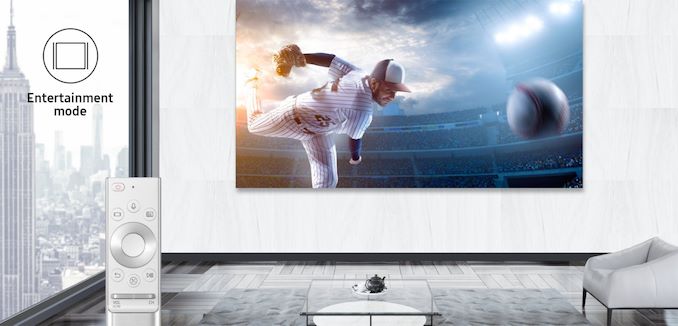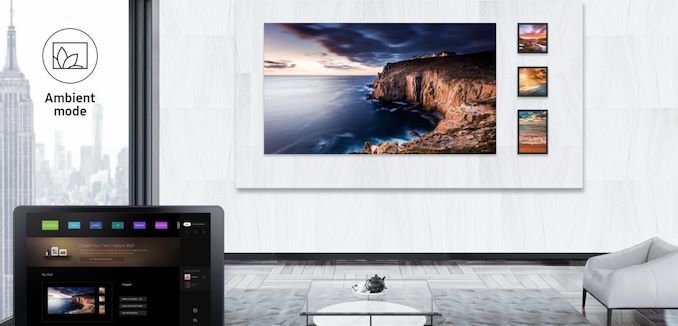Samsung’s Micro LED Wall TVs Now Available: Up to 8K, Up to 292-Inches
by Anton Shilov on October 3, 2019 9:15 AM EST
Samsung has started global sales of its Micro LED-based 'The Wall' display systems. The Wall televisions will be available in multiple configurations, but customized according to individual orders. The most basic Wall will offer a Full-HD resolution as well as a 73-inch size, wheareas the most advanced model will feature an 8K resolution and a 292-inch size.
Samsung’s The Wall televisions (IW008R) rely on the company’s bezel-less 806.4 × 453.6-mm Micro LED cabinets with a 960×540 resolution as well as 0.84-mm² individually-controlled LEDs. The building blocks feature 250 - 2000 nits brightness (regular/peak), around 10,000:1 contrast ratio, a 16-bit color depth, up to a 100/120 Hz refresh rate, as well as 155°/135° horizontal/vertical viewing angles. The modules also feature Samsung’s Black Seal and Ultra Chroma technologies to further improve contrasts and color saturation.
The Wall TVs come with a multimedia box based on Samsung’s Quantum Processor Flex SoC that supports a 20-bit internal processing, AI upscaling, video decoding, various HDR modes (HDR10+, LED HDR), and can run a variety of applications (Bixby, Netflix, YouTube, SmartThings, etc.).
As in case of competing Micro LED-based TVs, resolution of Samsung’s Wall televisions depends on their size. The Full-HD version uses only four cabinets and measures 73 inches in diagonal. By contrast, the 4K Full-HD model relies on 16 modules and therefore measures 146 inches. 6K and 8K Wall TVs feature 219-inch and 292-inch diagonals, respectively. Samsung can build non-standard bespoke Micro LED TVs as well for those who need them.
Samsung does not disclose pricing of its Wall televisions, but asks interested customers to contact it for an individual offering. That said, it is pretty obvious that pricing of Samsung’s Micro LED TVs will be well above MSRP of its ultra-premium QLED 4K or 8K televisions.
Related Reading:
- Sony’s Micro LED-Based Ultra-HD TVs Available to Consumers: 2K to 16K Resolutions, up to 790-Inches
- TCL Shows Off 132-Inch Micro LED 4K UHDTV: 24,000,000 Micro LEDs
- Sony Develops 16K Display: A 783-Inch ‘Crystal LED’ Screen
- Samsung at CES 2019: 219-Inch and 75-Inch Micro LED Ultra-HD TVs Demonstrated
Source: Samsung (via MicroLED-Info.com)














33 Comments
View All Comments
xenol - Thursday, October 3, 2019 - link
Actually I think I did my math wrong. Disregard.Santoval - Thursday, October 3, 2019 - link
You didn't. The article mentions that each LED is 0.84 mm². Assuming the LEDs are square (even if they aren't, by assuming they're square if you know their area you can guestimate their X & Y size) each LED is √ 0.84 sq mm = ~0.92 mm x ~0.92 mm. Or ~920 μm x ~920 μm. That is a *very* big pixel/LED that is firmly in the millimeter scale, not the micrometer scale. However I just calculated pixel size, not pixel/dot pitch (i.e. not the distance between the center of each pixel). So, let's calculate pixel pitch as well :A rectangle of 806.4 × 453.6 mm has a diagonal of 36.42 inches (I calculated that here : omnicalculator * com/math/diagonal-of-rectangle - the website's spam detector incorrectly interprets this link as spam...). From the 36.42" diagonal and the known resolution of 960 x 540 we can easily acquire the pixel pitch and the DPI/PPI.
The pixel pitch is 0.84 mm -still in the mm scale- and the PPI is a very low 30. Based on that very low PPI this is a display that needs to be viewed from very far, and the viewing distance will need to increase proportionally to the display's size. At its 6K configuration and above you don't need a house to view this comfortably, you need a dedicated private home theater.
rpg1966 - Friday, October 4, 2019 - link
It's a lot easier to just do 806.4/960 (or 453.6/540) = 0.84mm.edzieba - Thursday, October 3, 2019 - link
'MicroLED' is just a marketing term for individually addressable COB construction.xenol - Thursday, October 3, 2019 - link
Wouldn't addressable RGB strips technically fit this definition then?tarsius - Thursday, October 3, 2019 - link
The size of LEDs is micro. But the distance between pixels is much bigger than the size of a pixel. Hence the low PPI despite of microLED.Santoval - Thursday, October 3, 2019 - link
Not quite. If each LED has an area of 0.84-mm² that means it is ~0.92 mm x ~0.92 mm. That is definitely not micro, it's squarely in the millimeter scale, so they are technically miniLEDs. Based on the resolution of 960 x 540 and the diagonal of 36.42" (calculated from the module's size) then the pixel pitch (distance between the center of two pixels) is 0.84 mm, which is less than the pixel size, meaning the miniLEDs are packed quite tightly.What you described is what Sony did with their own microLED modules. They placed truly tiny, actual microLEDs inside huge black squares. As a result the microLEDs were just 1% of the display and the black squares were the other 99% (resulting in 99% lower brightness and 99% lower resolution). Based on the numbers quoted in this article though this is clearly not Samsung's approach.
s.yu - Friday, October 4, 2019 - link
Based on the numbers, Samsung's approach makes sense, Sony's is micro for micro's sake, whatever's the issue the tech isn't competitive at this point, it has zero advantage.Santoval - Saturday, October 5, 2019 - link
The issue is almost certainly overheating. Despite their very sparse microLEDs SONY's modules have a very thick and heavy cooling block on their back, with two rather large fans probably paired with a heavy copper cooler. The back side of the modules almost screams "I am hot!".Then it's the electronics. More (micro)LEDs probably means more and/or more complex electronics to control them, which in turn means more power draw and even more heat. I also doubt that the power draw of the LEDs scales down linearly as you make them smaller, which is probably why Samsung kept the LEDs large. Last but not least the (micro)LEDs need to be bright, *very* bright. Probably as bright as they can get without burning up for peak brightness, during which they operate in an "overdrive mode". High brightness means high power draw and high heat.
s.yu - Saturday, October 5, 2019 - link
Not much of that seems to make sense..."More (micro)LEDs probably means more and/or more complex electronics to control them"
Yet for the same power consumption Samsung drives 960x540 while Sony only drives 320x360...
Or by "More (micro)" you actually mean "smaller"? Which doesn't make sense either, they're just light bulbs after all, why are they significantly more complex to control when smaller?
"doubt that the power draw of the LEDs scales down linearly as you make them smaller, which is probably why Samsung kept the LEDs large"
But obviously doesn't explain why Sony chose to go small.
"High brightness means high power draw and high heat. "
Well in terms of actual output Samsung's is brighter, of course measuring by diode area Sony's is probably brighter, but again there seems to be a lack of practical advantage to the viewer.